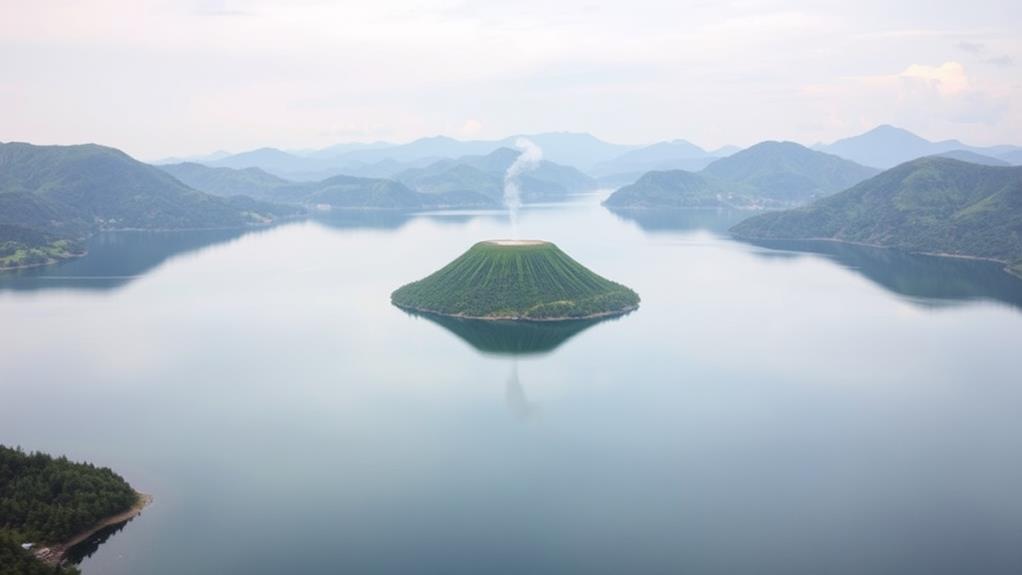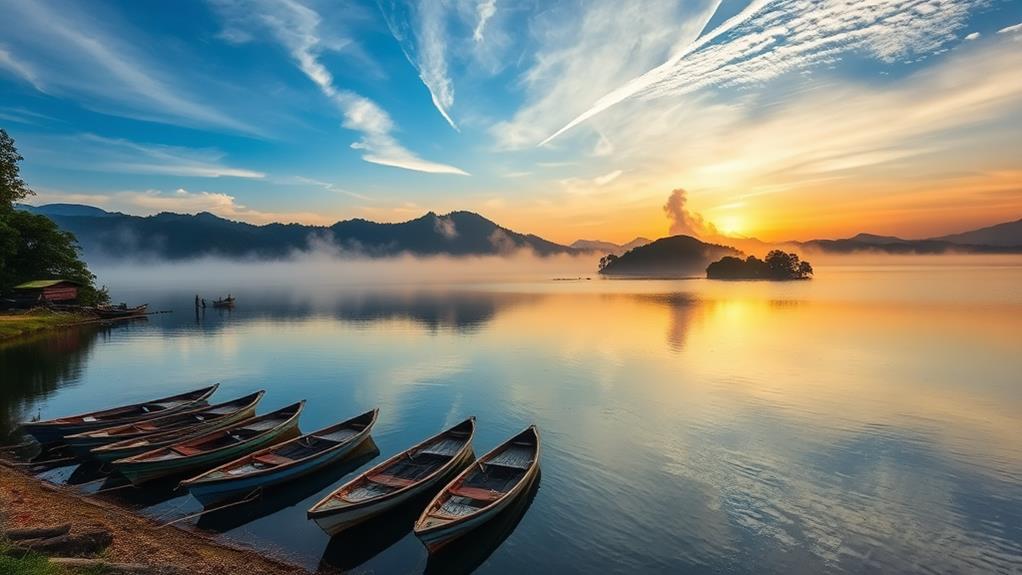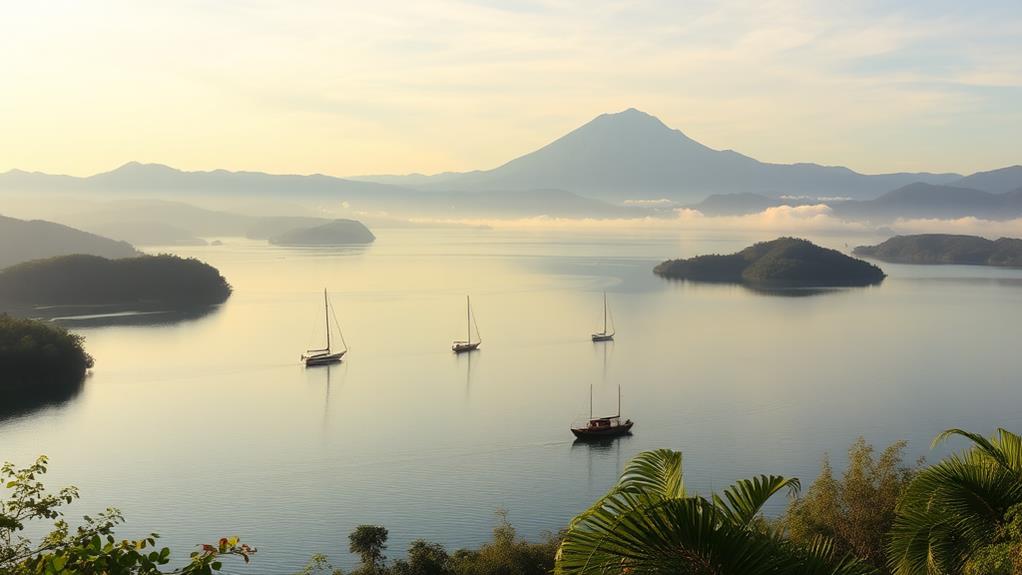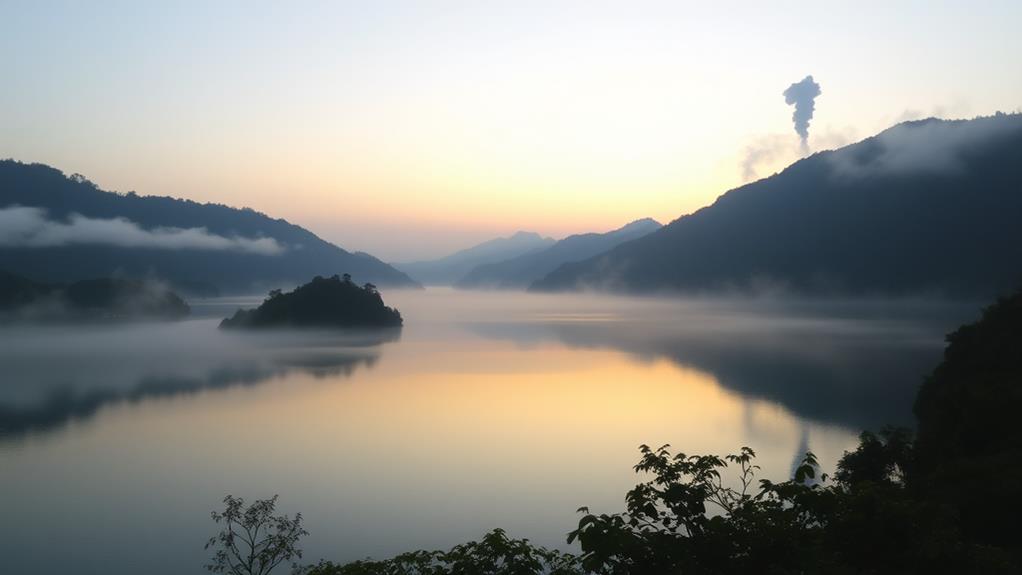Lake Taal: A Unique Blend of Geological Wonder and Volcanic Activity
Lake Taal is a scenic crater lake formed from 38 volcanic eruptions over 450 years, showcasing a unique blend of geological wonder and volcanic activity that has shaped its landscape. Visitors to Lake Taal can take in the breathtaking view from the rim of the crater, and take part in activities such as hiking or boating on the lake. For those interested in capturing the natural beauty and power of the area, there are opportunities for Mayon volcano photography, as well as other volcanic landscapes. The stunning vistas and unique geological features make Lake Taal a must-see destination for nature enthusiasts and photographers alike.
This lake covers an area of 265 square kilometers and features a main crater lake and a smaller one, with depths ranging from 100 to 150 meters.
The lake's water is characterized by decreased salinity due to rainfall, allowing freshwater species like Sardinella tawilis to adapt and thrive.
This delicate balance of geology, biodiversity, and human resilience is evident in the lake's emerald green waters.
Lake Taal's unique ecosystem is influenced by ongoing eruptions, which have created a dynamic environment for its diverse species.
The lake's cultural significance is also noteworthy, with its history and importance waiting to be explored further.
Geological Formation and Characteristics

Taal Lake's Formation and Characteristics
Formation: Thirty-eight volcanic eruptions over the past 450 years have shaped the landscape and ecology surrounding Taal Lake, a scenic crater lake situated within Taal Volcano's caldera.
These eruptions played a crucial role in forming the lake, isolating it from Balayan Bay and the South China Sea in the 18th century.
Size and Depth: Taal Lake spans approximately 265 square kilometers and reaches depths of 100-150 meters, making it the largest lake located on an island in a lake.
Geological Feature: The lake's unique geological feature is characterized as the world's largest double lake, with a main crater lake and a smaller crater lake on Volcano Island.
Salinity and Freshwater Species: Over time, the lake's salinity has decreased due to rainfall, allowing for the adaptation of freshwater species, including the endemic sardine, Sardinella tawilis.
Volcanic Activity and Eruptions
Taal Volcano's eruptions have significantly impacted the surrounding landscape and ecology. With at least 38 recorded eruptions in the past 450 years, Taal Volcano is classified as one of the sixteen Decade Volcanoes, monitored for its potential for hazardous eruptions and proximity to populated areas.
The volcano's eruptions have resulted in devastating consequences. The most recent major eruption in January 2020 led to significant evacuations and ashfall affecting nearby regions.
Historical eruptions, such as the catastrophic event in 1754, prompted the relocation of the Municipality of Taal, demonstrating the impact of volcanic activity on local communities.
Over 5,000 fatalities have been attributed to Taal's eruptions, highlighting the dangers posed by volcanic activity in densely populated regions.
The current cone of Taal Volcano, Volcano Island, has been shaped by centuries of volcanic eruptions. It rises from the center of Taal Lake, a prominent feature of the caldera's landscape.
Unique Ecosystem and Biodiversity

Taal Lake is home to a unique ecosystem that has adapted to its freshwater conditions, showcasing evolutionary changes in fish and other aquatic life. This ecosystem is characterized by species that have thrived in the lake's volcanic environment.
The lake is inhabited by endemic species, such as the Sardinella tawilis, the only freshwater sardine species in the world. Another notable inhabitant is the freshwater sea snake, Hydrophis semperi, which has adapted to the lake's conditions.
Over the past 300 years, the lake has experienced a significant decrease in salinity, leading to the extinction of historical marine species like sharks. This change is attributed to the lake's volcanic activity, which provides nutrient-rich soil and alters the environment.
The lake's biodiversity is heavily influenced by its volcanic activity, making it a significant subject for ongoing scientific research and ecological studies. These studies highlight the lake's importance in understanding volcanic impacts on biodiversity.
Cultural Significance and Heritage
Lake Taal's cultural fabric is woven from history, tradition, and resilience. The Historic Town of Taal features heritage structures from the Spanish colonial period, including the Minor Basilica of Saint Martin of Tours, the largest Catholic church in Asia.
Cultural practices reflect community resilience amidst volcanic hazards. The folk dance Subli, for instance, showcases the blending of cultures in the region.
Local agricultural heritage is unique and integral to the cultural landscape and economy. The region is known for Tawilis, an endemic sardine species, and Barako coffee, which are both important cultural and economic staples.
The region's volcanic activity has shaped the local communities' adaptability and resilience. Historical relocations of towns like Taal, Lipa, and Tanauan demonstrate this adaptability in the face of volcanic risks.
The importance of preserving both biodiversity and cultural heritage is recognized. The Taal Volcano Protected Landscape's designation as a National Park in 2018 acknowledges the intricate relationship between Lake Taal's natural and cultural significance.
Community Resilience and Adaptation

Community Resilience and Adaptation
The community surrounding Lake Taal has developed a resilient spirit due to centuries of volcanic activity, enabling them to adapt and thrive in the face of uncertainty.
Adapting to Volcanic Hazards
The community has demonstrated resilience by adapting to ongoing volcanic activity, relocating towns, and implementing significant evacuations. For instance, towns like Taal and Lipa were relocated after catastrophic eruptions, such as the 1754 event.
In 2020, tens of millions were affected by evacuations, showcasing the community's ability to respond to volcanic hazards.
Agricultural Practices
Residents have developed agricultural practices that leverage the fertile volcanic soil, enhancing crop productivity and supporting local economies despite the risks posed by eruptions. This has allowed the community to thrive in the face of uncertainty.
Cultural Continuity
Cultural continuity is maintained through heritage structures and practices in the Historic Town of Taal, where families have preserved their cultural identity even amidst natural threats. This has enabled the community to balance cultural identity with adaptation to volcanic activity.
Community Engagement
Local engagement initiatives emphasize community participation in disaster preparedness and resource management, ensuring sustainable development while addressing the challenges posed by Taal's volcanic activity. This has enabled the community to take charge of their own resilience and adaptation.
Resilience and Adaptation
The community's ability to balance cultural identity with adaptation to volcanic activity is a testament to their resilience and capacity to thrive in the face of uncertainty. This resilience is demonstrated through their ability to adapt to ongoing volcanic activity, develop agricultural practices, maintain cultural continuity, and engage in community initiatives.
Conservation Efforts and Management
The region surrounding Lake Taal is dedicated to conserving and managing its natural and cultural resources.
The Taal Volcano Protected Landscape (TVPL) is a National Park, designated as such in 2018, and is governed by a Protected Area Management Board. This board comprises the Department of Environment and Natural Resources (DENR) and local stakeholders, ensuring sustainable management of the region's resources.
Community engagement plays a vital role, with local ordinances like Municipal Ordinance No. 3 of 2009 safeguarding heritage structures.
Conservation initiatives focus on preserving biodiversity, such as the Hydrophis semperi (freshwater sea snake) and Sardinella tawilis (endemic sardine).
A legal framework, established through Presidential Proclamation No. 923 in 1996, protects the area's ecological and cultural heritage while addressing volcanic risks.
Tourism and Recreational Activities

Lake Taal: A Unique Geologic Wonder
Lake Taal is a captivating destination, renowned for its breathtaking emerald green waters and unique geological formations. As the largest lake on an island in a lake, surrounded by a volcano within, it offers a variety of recreational activities to explore.
Recreational Activities
Hiking to the crater provides a thrilling adventure, while horseback riding on Taal ponies offers a unique perspective.
Scenic boat rides, organized by local guides, allow visitors to explore the lake and its surroundings. Dining options with picturesque views of the lake offer a chance to sample local cuisine and gain cultural insights.
The lake's unique ecological features, such as the presence of a freshwater sea snake and endemic fish species, are also worth exploring.
Planning Your Visit
To make the most of your trip, plan your visit during the dry season. Consider taking early morning trips to avoid crowds.
With its blend of natural beauty, recreational activities, and cultural experiences, Lake Taal is an ideal destination for tourists and researchers alike.
Environmental Concerns and Threats
Lake Taal's ecosystem is threatened by various environmental concerns and hazards. Volcanic activity poses a significant risk, as the 2020 Taal Volcano eruption released ash and gases, affecting air quality and causing health concerns for nearby communities. This highlights the need for continuous monitoring and disaster preparedness, as over 5,000 fatalities have been recorded from past eruptions.
The lake's water quality is also at risk due to increased siltation and agricultural runoff, which can harm the endemic species that inhabit the area, such as the unique species of sea snakes.
Habitat changes and pollution threaten the local fauna, emphasizing the importance of conservation efforts in the region.
Preserving the lake's ecosystem and protecting surrounding communities is crucial, and addressing these environmental concerns is essential to achieve this goal.
What are the scenic features and activities around Lake Taal?
Located in the Philippines, Lake Taal is known for its scenic beauty and variety of activities. Visitors can explore the taal volcano eruption history at the Taal Volcano Island, enjoy boat rides, or immerse themselves in the lush surroundings of Taal Lake while taking in the picturesque views.
Scientific Research and Discoveries

Taal Volcano's Scientific Significance
Taal Volcano's 38 eruptions in the past 450 years have made it a crucial subject for scientific research. This research provides valuable insights into the geological landscape and local communities.
Unique Ecosystem and Adaptations
Taal Lake's ecosystem is home to the freshwater sea snake, Hydrophis semperi, which has adapted to the lake's changing salinity levels.
The lake's transition from saltwater to freshwater has led to unique evolutionary adaptations among fish species, showcasing the dynamic relationship between geology and biology.
Caldera Formation and Volcanic Processes
Geologists consider Taal Lake a prime site for studying caldera formation and volcanic processes, contributing valuable insights into the behavior of active volcanoes.
Monitoring Volcanic Activity
The Smithsonian Institution has played a significant role in monitoring Taal's volcanic activity, providing crucial data for understanding eruption patterns and mitigating risks to the surrounding population.
Ongoing Research and Importance
Ongoing research is essential for understanding the complex interactions between Taal's volcanic activity, the lake's ecosystem, and the local communities, ultimately informing strategies for sustainable development and risk management.
Frequently Asked Questions
Can You Swim in Taal Volcano Crater?
It isn't recommended to swim in Taal Volcano Crater Lake.
Swimming in a volcanic crater lake poses health risks due to the presence of volcanic gases, which can cause respiratory problems, and high acidity levels, which can irritate the skin and eyes.
Additionally, the water temperature can vary unpredictably, making it difficult to ensure a safe swimming experience.
Instead, consider exploring the crater through boating or hiking, which allow you to appreciate the unique ecosystem while prioritizing your safety.
These activities provide a safe and controlled environment to experience the natural beauty of the volcanic crater lake.
Why Is Taal Lake Famous?
Taal Lake is famous for its unique volcanic landscape and geological features. It's the largest lake on an island in a lake, making it a standout among tourist attractions. This rare formation draws visitors from around the world who are interested in science, nature, and adventure.
The lake's emerald green color and heart-shaped appearance contribute to its allure. Its rich biodiversity is another key feature, with a variety of plant and animal species found in and around the lake.
These features make Taal Lake a popular destination for scientists, nature enthusiasts, and adventure-seekers alike.
How Many People Died in the Taal Volcano Eruption 1911?
1,335 people died in the devastating 1911 eruption of Taal Volcano.
This catastrophic event was mainly caused by the intense explosion and subsequent ashfall.
The volcanic aftermath had a profound local impact, destroying structures and displacing thousands of residents.
The eruption's severity prompted the Philippine government to implement measures to enhance community resilience and response to future volcanic events.
Is Taal Volcano Active?
Yes, Taal Volcano is active. As one of the Philippines' most active volcanoes, it has a history of frequent eruptions, with at least 38 recorded events over the past 450 years.
The Philippine Institute of Volcanology and Seismology (PHIVOLCS) closely monitors its activity, tracking geothermal heat and gas emissions. For example, the 1754 eruption lasted months and was an explosive event.
The ongoing geothermal activity will continue to have effects on the surrounding area.